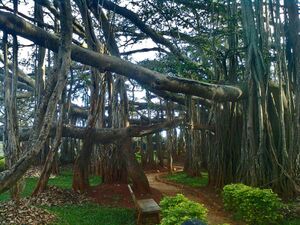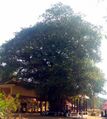بانيان
| Banyan | |
|---|---|

| |
| Banyan with characteristic adventitious prop roots | |
| التصنيف العلمي | |
| أصنوفة غير معروفة (أصلحها): | Ficus subg. Urostigma |
| الأنواع | |
بانيان ( banyan، وتـُتهجى أيضاً banian ؛ /ˈbænjən/ BAN-yən),[1] is a fig that develops accessory trunks from adventitious prop roots, allowing the tree to spread outwards indefinitely.[2] This distinguishes banyans from other trees with a strangler habit that begin life as an epiphyte,[3] i.e. a plant that grows on another plant, when its seed germinates in a crack or crevice of a host tree or edifice. "Banyan" often specifically denotes Ficus benghalensis (the "Indian banyan"), which is the national tree of India,[4] though the name has also been generalized to denominate all figs that share a common life cycle and used systematically in taxonomy to denominate the subgenus Urostigma.[5]
. . . . . . . . . . . . . . . . . . . . . . . . . . . . . . . . . . . . . . . . . . . . . . . . . . . . . . . . . . . . . . . . . . . . . . . . . . . . . . . . . . . . . . . . . . . . . . . . . . . . . . . . . . . . . . . . . . . . . . . . . . . . . . . . . . . . . . . . . . . . . . . . . . . . . . . . . . . . . . . . . . . . . . . .
السمات
Like other fig species, banyans bear their fruit in the form of a structure called a "syconium". The syconium of Ficus species supply shelter and food for fig wasps and the trees depend on the fig wasps for pollination.[بحاجة لمصدر]
Frugivore birds disperse the seeds of banyans. The seeds are small, and because most banyans grow in woodlands, a seedling that germinates on the ground is unlikely to survive. However, many seeds fall on the branches and stems of other trees or on human edifices, and when they germinate they grow roots down toward the ground and consequently may envelop part of the host tree or edifice. This is colloquially known as a "strangler" habit, which banyans share with a number of other tropical Ficus species, as well as some other unrelated genera such as Clusia and Metrosideros.[2][6][7][صفحة مطلوبة][8]
The leaves of the banyan tree are large, leathery, glossy, green, and elliptical. Like most figs, the leaf bud is covered by two large scales. As the leaf develops the scales abscise. Young leaves have an attractive reddish tinge.[9]
Older banyan trees are characterized by aerial prop roots that mature into thick, woody trunks, which can become indistinguishable from the primary trunk with age. These aerial roots can become very numerous. the Kolcatta (Calcutta) Banyan, which has been tracked carefully for many years, currently has 2,880 supplementary trunks.[10] Such prop roots can be sixty feet (eighteen meters) in height.[11][12] Old trees can spread laterally by using these prop roots to grow over a wide area. In some species, the prop roots develop over a considerable area that resembles a grove of trees, with every trunk connected directly or indirectly to the primary trunk. The topology of this massive root system inspired the name of the hierarchical computer network operating system "Banyan VINES".[بحاجة لمصدر]
In a banyan that envelops its host tree, the mesh of roots growing around the latter eventually applies considerable pressure to and commonly kills it. Such an enveloped, dead tree eventually decomposes, so that the banyan becomes a "columnar tree" with a hollow, central core. In jungles, such hollows are very desirable shelters to many animals.[بحاجة لمصدر]
From research, it is known that the longevity of banyan tree is due to multiple signs of adaptive (MSA) evolution of genes.[13]
أصل الاسم
The name was originally given to F. benghalensis and comes from India, where early European travelers observed that the shade of the tree was frequented by Banyans (a corruption of Baniyas, a community of Indian traders).[14]
التبويب
The original banyan, F. benghalensis, can grow into a giant tree covering several hectares. Over time, the name became generalized to all strangler figs of the Urostigma subgenus. The many banyan species also include:
- Ficus microcarpa, which is native to Pakistan, India, Nepal, Bangladesh, Bhutan, Sri Lanka, China, Taiwan, the Malay Archipelago, Mainland Southeast Asia, New Guinea, Australia, Ryukyu Islands and New Caledonia, is a significant invasive species elsewhere.[15]
- The Central American banyan (Ficus pertusa) is native to Central America and northern South America, from southern Mexico south to Paraguay.[بحاجة لمصدر]
- The shortleaf fig (Ficus citrifolia) is native to South Florida, the Caribbean islands, Central America, and South America south to Paraguay. One theory is that the Portuguese name for F. citrofolia, os barbados, gave Barbados its name.[بحاجة لمصدر]
- The Florida strangler fig (Ficus aurea) is also native to South Florida and the Caribbean islands, and distinguished from the above by its coarser leaf venation.[بحاجة لمصدر]
- The Moreton Bay fig (Ficus macrophylla) and Port Jackson fig (Ficus rubiginosa) are other related species.[بحاجة لمصدر]
في البستنة
Due to the complex structure of the roots and extensive branching, the banyan is used as a subject specimen in penjing and bonsai. The oldest living bonsai in Taiwan is a 240-year-old banyan tree housed in Tainan.[16]
في الثقافة
الدين والأسطورة
Banyan trees figure prominently in several Asian and Pacific religions and myths, including:
- In the Bhagavat Gita, Krishna said, "There is a banyan tree which has its roots upward and its branches down, and the Vedic hymns are its leaves. One who knows this tree is the knower of the Vedas." (Bg 15.1) Here the material world is described as a tree whose roots are upwards and branches are below. We have experience of a tree whose roots are upward: if one stands on the bank of a river or any reservoir of water, he can see that the trees reflected in the water are upside down. The branches go downward and the roots upward. Similarly, this material world is a reflection of the spiritual world. The material world is but a shadow of reality. In the shadow there is no reality or substantiality, but from the shadow we can understand that there is substance and reality.
- Vat Purnima is a Hindu festival related to the banyan tree. Vat Purnima is observed by married women in North India and in the Western Indian states of Maharashtra, Goa, Gujarat.[17] During the three days of the month of Jyeshtha in the Hindu calendar (which falls in May–June in the Gregorian calendar) married women observe a fast and tie threads around a banyan tree and pray for the well-being of their husbands.[18]
- In Buddhism's Pali canon, the banyan (Pali: nigrodha)[19] is referenced numerous times.[20] Typical metaphors allude to the banyan's epiphytic nature, likening the banyan's supplanting of a host tree as comparable to the way sensual desire (kāma) overcomes humans.[21]
- In Guam, the Chamorro people believe in tales of taotaomona, duendes, and other spirits. Taotaomona are spirits of the ancient Chamorro that act as guardians to banyan trees.[22]
- In Vietnamese mythology of the Mid-Autumn Festival, the dark markings on the Moon are a banyan, a magical tree originally planted by a man named Cuội on Earth. When his wife watered it with unclean water, the tree uprooted itself with the man hanging on it and flew to the Moon, where he eternally accompanied the Moon Lady and the Jade Rabbit.[23][24]
- In the Philippines, they are usually referred to as balete trees, which are home to certain deities and spirits.[25]
- In Okinawa, the tree is referred to as gajumaru, which, according to traditional folklore, is the home for the mythical Kijimuna.[بحاجة لمصدر]
أبرز أشجار البانيان
- Thimmamma Marrimanu is a banyan tree in Anantapur, located circa 35 kilometres (22 mi) from the town of Kadiri in the state of Andhra Pradesh, India. It is present in the Indian Botanical Gardens and is more than 550 years old. Its canopy covers 19,107 m2 (4.721 acres) [26]
- One of the largest trees, the Great Banyan is found in Kolkata, India. Its canopy covers 4.67 acres (1.89 ha)[بحاجة لمصدر]
- Another such tree, Dodda Aalada Mara as in "Big Banyan Tree", is found in the village of Ramohalli, on the outskirts of Bangalore, India; it has a spread of circa 2.5 acres.[27]
- The Iolani Palace banyans in Honolulu, Hawaii. In the 1880s Queen Kapiolani planted two banyan trees within the Iolani Palace grounds. These trees have since grown into large groupings of trees on the old historic palace grounds.[28]
- Maui, Hawaii has the Banyan Tree in Lahaina planted by William Owen Smith on April 24, 1873 in Lahaina's Courthouse Square to mark the 50th anniversary of the arrival of the first American Protestant mission. It has grown to cover two-thirds of an acre.[27] The tree was severely damaged by the 2023 Hawaii wildfires from August 8–9 which also severely damaged the town of Lahaina.[29]
- One large banyan tree, Kalpabata, is inside the premises of Jagannath Temple in Puri. It is considered sacred by the devotees and is supposed to be more than 500 years old.[30]
- A large banyan tree lives in Cypress Gardens, at the Legoland theme park located in Winter Haven, Florida. It was planted in 1939 in a 5-gallon bucket.[31]
- Adayar Banyan Tree, located in the Theosophical Society Campus in Adayar, Chennai, India, is around 450 years old.
غيرهم
- The banyan tree is depicted in the coat of arms of Indonesia as a manifestation of the third principle of Pancasila (the unity of all of Indonesia). It is also used in the emblem of Golkar.[بحاجة لمصدر]
- The Economist magazine features an opinion column covering topics pertaining to Asia named "Banyan".[32]
- In southern Vanuatu, the clearings under banyan trees are used as traditional meeting places. The quarterly newsletter of the British Friends of Vanuatu Society is named Nabanga, after the local word for banyan.[33]
- The Banyan Tree is a notoriously difficult room in the 1984 ZX Spectrum platform game Jet Set Willy.[34]
- Vadodara, a city in Gujarat, India, is literally named after Banyan trees. Banyan, locally known as Vad were found in abundance here.[بحاجة لمصدر]
- The Foggy Swamp in Avatar: The Last Airbender consists of a single banyan grove tree.[35]
- The title track from Steely Dan's 1977 album Aja contains the lyric "Chinese music under banyan trees, here at the dude ranch, above the sea."[36]
- On 13 December 2021, Chinese Communist Party (CCP) general secretary Xi Jinping personally intervened to punish and demote 10 CCP officials in Guangzhou after they cut down or uprooted thousands of banyan trees.[37]
Also featured in the TV show LOST, when John Locke uses them as cover to hide from the sinister black smoke monster.
معرض صور
Early stages of a strangler fig on a host tree in the Western Ghats, India
During Vat Purnima festival, married women tying threads around a banyan tree.
Ficus tree in front of Sarkaradevi Temple, Kerala, India.
The Great Banyan in Kolkata, India.
The coat of arms of Indonesia depicts a banyan tree.
انظر أيضاً
. . . . . . . . . . . . . . . . . . . . . . . . . . . . . . . . . . . . . . . . . . . . . . . . . . . . . . . . . . . . . . . . . . . . . . . . . . . . . . . . . . . . . . . . . . . . . . . . . . . . . . . . . . . . . . . . . . . . . . . . . . . . . . . . . . . . . . . . . . . . . . . . . . . . . . . . . . . . . . . . . . . . . . . .
المراجع
- ^ "Banian". Dictionary.com. Random House. Retrieved 15 March 2016.
- ^ أ ب Armstrong, Wayne (October 1999). "Stranglers & Banyans". Wayne's Word. Retrieved 26 August 2022.
- ^ Laman, Timothy G. (1995). "The Ecology of Strangler Fig Seedling Establishment". Selbyana. 16 (2): 223–9. JSTOR 41759910.
- ^ "National Tree". Know India. Government of India. Archived from the original on 13 February 2016. Retrieved 16 January 2012.
- ^ Note the use of "Banyan" versus "banyan" in Athreya, Vidya R. (July 1997). "Nature Watch: Trees with a Difference: The Strangler Figs". Resonance. 2 (7): 67–74. doi:10.1007/BF02838593. S2CID 125012527.; also "Aerial-Rooting Banyan Trees". Natural History Guide To American Samoa. University of Washington. Archived from the original on 4 September 2007.
- ^ Zhou Zhekun; Gilbert, Michael G. (2003). "Moraceae" (PDF). In Zhengyi Wu; Raven, Peter H.; Deyuan Hong (eds.). Flora of China. Vol. 5. pp. 21–73. ISBN 978-1-930723-27-6. Archived from the original (PDF) on 1 September 2006.
- ^ Serventy, Vincent (1984). Australian Native Plants. Frenchs Forest, NSW: Reed. ISBN 978-0-7301-0020-1.
- ^ "Light in the Rainforest" (PDF). Tropical Topics. Vol. 1, no. 5. Queensland Department of Environment and Heritage. 1992. p. 1. Archived from the original (PDF) on 29 May 2009.
- ^ "The Banyan Tree". The Lovely Plants. 14 September 2010.
- ^ Allen, Richard; Baker, Kimbal (2009). Australia's Remarkable Trees. Melbourne: Miegunyah Press. p. 100.
- ^ Florist and Pomologist, (February 1867) page 37
- ^ The Garden (London),Volume 3 (February 8, 1873) page 115
- ^ Prasad, R. (2022-12-17). "Genes responsible for long lifespan of banyan, peepal trees identified". The Hindu (in الإنجليزية). ISSN 0971-751X. Retrieved 2022-12-28.
- ^ Yule, Henry; Burnell, Arthur Coke (1903). Crooke, William (ed.). Hobson-Jobson: A glossary of colloquial Anglo-Indian words and phrases, and of kindred terms, etymological, historical, geographical and discursive (New ed.). London: J. Murray. p. 65.
- ^ "Ficus microcarpa L.f. | Plants of the World Online | Kew Science". Plants of the World Online (in الإنجليزية). Retrieved 9 September 2020.
- ^ "Small Is the Old Big". Taipei Times. 22 September 2005.
- ^ Kerkar, Rajendra P (7 June 2009). "Vat-Pournima: Worship of the banyan tree". The Times of India. Retrieved 18 July 2021.
- ^ "Mumbai: Women celebrate Vat Purnima at Jogeshwari station". Mid Day. 2 June 2015. Retrieved 18 July 2021.
- ^ Pali Text Society, London (1921–1925). Rhys Davids, T. W.; Stede, William (eds.). The Pali Text Society's Pali-English dictionary. Chipstead. p. 355, entry "Nigrodha,". Retrieved 22 November 2008.
{{cite book}}: CS1 maint: location missing publisher (link) - ^ See, for instance, the automated search of the SLTP ed. of the Pali Canon for the root "nigrodh" which results in 243 matches "Search term 'Nigrodh' found in 243 pages in all documents". Bodhgayanews.net. Archived from the original on 2 December 2008. Retrieved 22 November 2008.
- ^ See, e.g., SN 46.39, "Trees [Discourse]," trans. by Bhikkhu Bodhi (2000), Connected Discourses of the Buddha: A Translation of the Saṃyutta Nikāya (Boston: Wisdom Publications), pp. 1593, 1906 n. 81; and, Sn 2.5 v. 271 or 272 (Fausböll, 1881, p. 46).
- ^ "Ghost stories: Taotaomona, duendes and other spirits inhabit Guam". Pacific Daily News. Guam. 28 October 2007.
- ^ "Chú Cuội or The Man in the Moon". VIETNAM.COM.
- ^ "Vietnam's magical Mid-autumn Festival". Vietnam Tourism.
- ^ Mellie Leandicho Lopez (2006). A Handbook of Philippine Folklore. University of the Philippines Press.
- ^ "The World's Largest Banyan Tree". Atlas Obscura (in الإنجليزية). Retrieved 2 August 2019.
- ^ أ ب John R. K. Clark (2001). Hawai'i place names: shores, beaches, and surf sites. University of Hawaii Press. p. 23. ISBN 978-0-8248-2451-8.
- ^ Friday Frights: The Ghosts Who Haunt Hawai‘i’s Historic ‘Iolani Palace Honolulu Magazine. By Diane Lee. 6 October 2017. Downloaded 22 September 2018.
- ^ Anguiano, Dani (August 10, 2023). "'Heartbeat of Lahaina Town': wildfire chars beloved 150-year-old banyan tree". The Guardian. Retrieved August 14, 2023.
- ^ "Attractions of Jagannath Temple, Temples inside Jagannath Temple, Bedha Parikrama". www.shreekhetra.com.
- ^ "LEGOLAND Florida The Belle of Theme Parks". 20 October 2011. Archived from the original on 27 August 2013. Retrieved 15 July 2013.
- ^ "In the shade of the banyan tree". The Economist. 8 April 2009.
- ^ Home Page
- ^ "CRASH 4 - Jet Set Willy". www.crashonline.org.uk.
- ^ "The Swamp". Avatar: The Last Airbender. No. 4, season 2.
- ^ "Lyrics | Aja". sdarchive.com. Retrieved 2023-08-11.
- ^ "China's Xi Intervenes to Punish Local Officials for Killing Trees". Bloomberg News. 13 December 2021. Retrieved 18 December 2021.
وصلات خارجية
- Stranglers and Banyans, palomar.edu
- Plant Cultures: Banyan tree history and botany, plantcultures.org.uk









